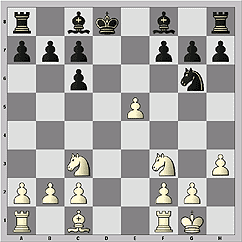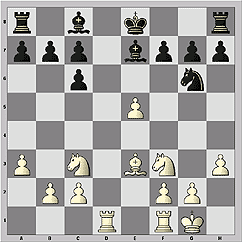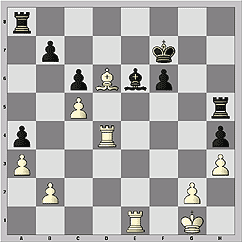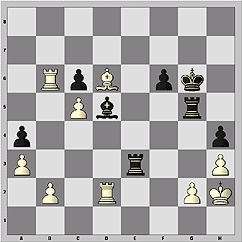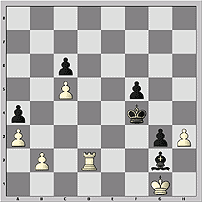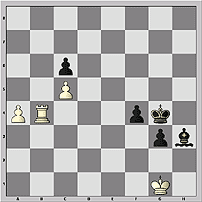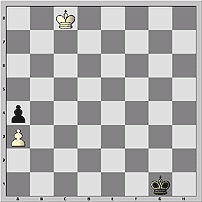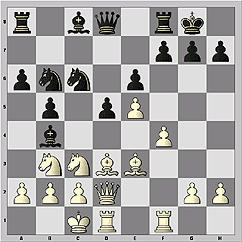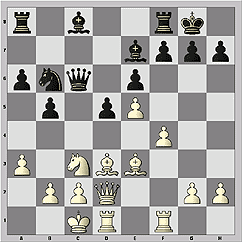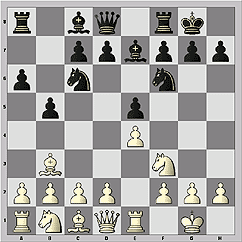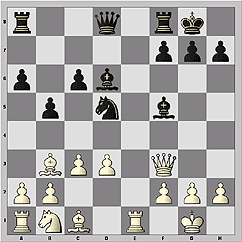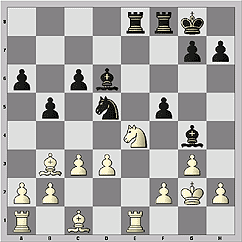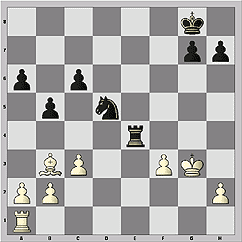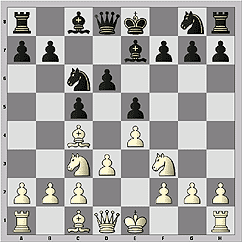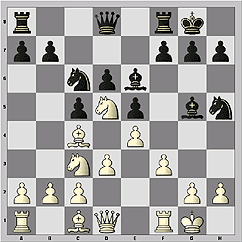 | Последние турниры |
Чемпионат России
СуперФинал

02.12.2006
Суперфинал чемпионата России проходит в Москве, в ЦДШ им. М.М.Ботвинника со 2 по 15 декабря при 12 участниках по круговой системе.
Крамник - Fritz

25.11.2006
С 25 ноября по 5 декабря в Бонне чемпион мира Владимир Крамник сыграет матч из 6 партий с программой Deep Fritz. В случае победы Крамник получит 1 миллион долларов, тем самым удвоив свой стартовый гонорар ($500000).
Мемориал Таля

5.11.2006
В Москве с 5 по 19 ноября проходил Мемориал Таля, в программе которого супертурнир 20-й категории и выдающийся по составу блицтурнир. Призовой фонд каждого состязания - 100.000 долларов.
Топалов - Крамник

23.09.2006
После того как "основное время" не выявило победителя (счет 6:6), 13 октября соперники сыграли 4 дополнительных поединка с укороченным контролем времени.
Томск. Высшая лига

2.09.2006
Со 2 по 11 сентября Томск принимает Высшую лигу чемпионата России 2006 года. В турнире участвуют 58 шахматистов - как получившие персональные приглашения, так и победившие в отборочных состязаниях.
Майнц

17.08.2006
В последние годы фестиваль в Майнце вслед за "Амбер-турниром" стал центром легких шахматных жанров. Наряду с массовыми ристалищами традиционно проходят чемпионские дуэли.
Россия - Китай

10.08.2006
С 10 по 20 августа в Китае проходит товарищеский матч сборных России и Китая. В нынешнем поединке как мужчины, так и женщины соревнуются на пяти досках по шевенингенской системе в два круга.
Все материалы
ChessPro

|
|

|
|
 |
By grandmaster
Sergey SHIPOV |
Nascence of Supernova! |
Human intellect can’t embrace this grandiose space phenomenon. The explosion of an old star, shedding off old its old shell entails large-scale substance dilation and colossal energy outburst (about 10 raised to power 46) begetting nebulas, neutron stars and black holes. Nascence of supernova is such an outstanding phenomenon that it overshadows whole constellations and galaxies.
Doesn’t it remind you anything? That is Veselin Topalov! Nowadays, when 18-year old guys become world champions, 30 can be called the veteran age. Veselin has many tournaments behind him with the results ranging from brilliant to bad. As a chess player Topalov molded many years ago. Never dissembling his ambitions he fought hard but failed to reach the very top. He just could not make it…
All of the sudden Topalov exploded! Having raised his game to a new level, he astonished chess world with fantastic energy outburst, brilliant opening, physical and psychological preparation. Let’s recall his amazing 9.5 out of 10 in Tripoli on the road to the final. This year we saw his tie with Kasparov in Linares (Veselin beat Garry in the head to head encounter) and outstanding finish in Sofia (the victories over Anand and Kramnik). Finally, the time came for Vaselin’s triumph at the World Championship.
Chess world got the worthy champion. Now Veselin is in for a tough glory test. I hope Topalov will bear this heavy load and become a historical figure. He is a natural born fighter. The Bulgarian has a character of a real champion. Hunger for victories, he strives for the maximum result. Chess needs such a leader.
Don’t you forget the consequences of supernova nascence? I am talking about nebula covering our future. Further FIDE’s actions and Tolapov’s steps are unclear. What will happen next? The match with Kramnik or Kasparov, a new cycle involving all chess players? Let’s hope that all these projects (particularly the third one, which, I am sure, many will vote for) won’t sink into oblivion and vanish in the haze of anarchy and lack of will.
In 13th round all games were drawn, although the encounter followed different scenarios. Naturally, the leader’s board was in the limelight.
Ruy Lopez C67
Rustam KASIMDZHANOV (UZB) – Veselin TOPALOV (BUL)
1.e4 e5 2.Nf3 Nc6 3.Bb5 Nf6. The latest games proved reliability of the Berlin system. Let well alone, there is no need to run risks – I think that is what Topalov thought when choosing the opening.
4.0–0 Nxe4 5.d4 Nd6 6.Bxc6 dxc6 7.dxe5 Nf5 8.Qxd8+ Kxd8 9.Nc3 Ne7 10.h3 Ng6.
11.Be3!? It looks like developing the bishop to this square is getting popular. Formerly White mainly fianchettoed this piece to b2. From this position the bishop covers the e-pawn and does not stay on the way of White’s rooks. As this game demonstrated the e5-pawn does not need protection. The bishop will protect another white infantryman on f4. There is no pawn on this square? Don’t worry it will advance there pretty soon.
11...Be7 12.Rad1+ Ke8 13.a3. Frankly speaking this move looks somewhat strange after Black’s developing the bishop to e7. On the other hand this move is quite possible as well as the sortie Be7-b4 if it is not made.
13...h5. This new move is a clear improvement comparing to the game Parligras – Postny (Budapest, 2005) which saw13...Be6 14.Rfe1 h5 15.Nd4 Bd7 16.Bc1 Nf8 17.Ne4 c5 18.Ne2 Bc6 19.Nf4 Ne6 20.Nd5 h4 draw. The position is about equal here.
14.Rfe1 (Black is in no hurry to determine the position of his light-squared bishop) 14...h4 15.Nd4 (White has made an important step toward fulfillment of his plans; the e5-pawn is left under attack) 15...a6. Black is preparing c6-c5. Obviously 15...Nxe5 16.Bf4 f6 17.Bxe5 fxe5 18.Nf3 etc. was too risky as White has an active play.
16.f4 Rh5. Black opted for the most solid move. Probably after 16...c5 17.Nd5 Bd8 White has some concrete ideas, but they are no evident. On the other hand Black’s bishop on d8 is not something to brag about. Dangerous was 16...Bd7 17.f5! Nxe5 18.Bf4 Nc4 19.Bxc7 Kf8 20.b3 Rc8 (20...Nxa3 21.Rxe7 Kxe7 22.Re1+ Kf8 23.Bd6+) 21.Bf4 Nb6.
17.Ne4. Black has many options here.
17...Bd7 (I can’s see why Black refrained from 17...c5!? followed by b7-b6) 18.c4. White has conceived an interesting plan to put a clamp on Black’s position. Usually White advances the pawn to c4 only after its black colleague’s appearance on c5.
18...a5. The following line illustrates White’s important tactical resource: 18...Nf8 19.f5! Bxf5 (19...c5 20.f6!) 20.g4! – White’s pawn takes no heed of en passant rule – 20...hxg3 21.Nxg3 and Black loses material.
19.c5 a4 (Black has fixed White’s queenside but weakened his a4-pawn.) 20.Rc1! White immediately jumps on Black’s last move. As soon as White’s rook has reached c4, one of the knights has taken up the c3-square Black will lose his pawn broken away from the main forces.
20...f5! (a courageous move by the person who is used to defying danger) 21.exf6 (After 21.Nf2 Nf8! Black has no problems as he transfer one of the pieces to e6 blockading the white pawn) 21...Bxf6! Precise calculation. In the line 21...gxf6 22.f5 Ne5 (22...Bxf5 23.g4!!) 23.Nxf6+ Bxf6 24.Bf4 Kf7 25.Bxe5 Black does not have sufficient compensation for the pawn.
22.f5. It looks like White has nothing better. Actually in this particular position it is noticeable that the e3-knight really hampers its own rooks.
22...Ne7 23.Nxf6+ gxf6 24.Bf4 Kf7 25.Bxc7 Nxf5 26.Rc4! Nxd4 27.Rxd4 Be6 28.Bd6. Evidently, Black has to struggle in the opposite-colored bishop endgame down a pawn. Had Rustam known what he was in for IN REALITY! I am sure he was looking forward to playing for win for 100 moves running no risks…
28...Ra5 (the rooks has made first step toward its glorious demise) 29.Rde4. I could not figure out during the game I don’t understand it right now Veselin was going to activate his forces after the prophylaxis move 29.Re2!
29...Bd5 (Black has created a tangible counterplay as the g2 pawn is really weak) 30.Re7+ Kg6 31.Rxb7 Rb5! 32.Rb6. White’s reluctance to simplify the position is quite understandable. After 32.Rxb5 cxb5 White has problems advancing his passer.
32...Rg5 33.Re2 Rb3 34.Kh2?! Apparently, Rustam underestimated the opponent’s chances. White should have traded the rooks and transferred his king to h2. Indeed after that White can attack or at least exchange the h2-pawn. In this case slow pressing is quite possible.
34...Re3 35.Rd2. Topalov demonstrated his subtle positional touch. As the white rook has lingered on b6 Veselin resolutely capitalize on his temporary advantage a narrow section of the front.
35...Reg3!! This grandiose move drastically changes the turn of the battle. Black intercepts the initiative. The effect of this move was amplified by Kasimdzhanov’s time trouble.
36.Bxg3 hxg3+ 37.Kh1. White can’t solve his problems with 37.Kg1 Re5 38.Rd1 (38.Kf1? Bc4+) 38...Re2 – the g2-pawn falls.
37...Rf5 (Black’s powerful bishop looks really impressive) 38.Rd1 Rf2. Probably at this point Rustam realized that the planned 39.Rg1 is met with the pawn lunge to f3 – 39...f5! etc.
39.Rb8! (right decision; only active rooks can help White save the game) 39...f5 40.Rd8 (White has to eliminate this killer-bishop as soon as possible) 40...Bxg2+ 41.Kg1. By this moment it became clear that the draw secures Veselin the title. That is why he decided to play for win with a safety margin.
41...Bd5. The line 41...f4 42.R1d6+ Kf5 43.Rf8+ leads to an immediate draw by perpetual. I think in an ordinary game free from the pressure and the responsibility for the result Veselin would have played 41...Kg5! (pointed out by Alexey Shirov in our forum) with good practical chances for the victory and some chances to lose the game. Who knows what may happened in the heat of the battle?
Thus, Black is going to gradually build up the pressure and promote his pawns. The analysis of this position is very complicated. There are many long variations and sub-lines. Check out what I managed to dig out forthwith: 42.R1d3! All other continuation are inferior. Now innocuous is 42...f4 43.Rg8+ as Black can’t advance his king – 43...Kf5 44.Rdxg3! Therefore he should play 42...Kf4!
White faces a serious problem. How should he defend? The active operations with the rooks results in Black’s surprising victory: 43.Rh8 Rc2 44.Rc3 Rd2! 45.Rh4+ Kg5 46.Rh8 f4 47.Rg8+ Kf5 48.Rf8+ Ke5 49.Rc1 (49.Re8+ Kd4!) 49...Be4 50.Re1 Rg2+ 51.Kf1 Rf2+ 52.Kg1 Kd4 53.Ra8 Rg2+ 54.Kf1 Rh2 55.Rxa4+ Kxc5 56.Rexe4 f3!
How do you like this picture? White has no escape. Let’s get back to the key position – 41...Kg5 42.R1d3 Kf4 – it looks like White should trade the rooks – 43.Rd2!? Rxd2 44.Rxd2
There are three sub-lines this time by Black: 44...Bxh3 45.Rd8 Kf3 (the line 45...Kg4 46.Rg8+ Kf3 47.Rh8! does not change much as 45...Bg4 46.Ra8 Ke3 47.Rg8! leads nowhere) 46.Rh8 Bg4 – it is time for a breakthrough – 47.b3! axb3 48.Rb8 f4 49.Rxb3+ Ke4 50.Rb4+ Ke5 51.a4 Bh3 52.Rb3 Ke4 53.Rb4+ Kf5 54.Rb3 Kg4 55.Rb4
Draw! Lets return to the crossroads one more time: 41...Kg5 42.R1d3 Kf4 43.Rd2 Rxd2 44.Rxd2, and make the most consistent move 44...Be4 45.Rd8 Ke3 46.Rg8 f4 White has the only salvation 47.Kf1! (47.h4? f3! 48.Rxg3 Ke2–+) 47...Bd3+ 48.Kg2 Be4+ 49.Kf1
49...Bf5 (49...Bd5 50.Rg7) 50.Kg2 – Black can’t make progress.
Let me repeat that these variations are the result of my FIST analytical exploration. Probably further research will change the verdict.
42.R8xd5! (precise path to the draw) 42...cxd5 43.Rc1 Rxb2 44.c6 Rb8 45.Kg2 f4 46.Kf3 Kg5.
Rustam played 47.h4+ and offered a draw which was accepted.
The opponents could have proceed with 47...Kxh4 48.Kxf4 g2 49.Ke5 Kh3 50.c7 Rc8 51.Kxd5 Kh2 (51...Rxc7? 52.Rxc7 g1Q 53.Rh7+ Kg2 54.Rg7+ Kh2 55.Rxg1 Kxg1 56.Kc5+–) 52.Kd6 g1Q 53.Rxg1 Kxg1 54.Kd7 Rh8 55.c8Q Rxc8 56.Kxc8
56...Kf2 57.Kc7 Ke3 58.Kc6 Kd4 59.Kb5 Kd5 60.Kxa4 Kc6 and the result is obvious.
Vishy failed to take revenge for his first round defeat. He sacrificed the bishop but the attack was sufficient only for a draw.
French Defense C11
Vishwanathan ANAND (IND) – Alexander MOROZEVICH (RUS)
1.e4 e6 2.d4 d5 3.Nc3 Nf6 4.e5 Nfd7 5.f4 c5 6.Nf3 Nc6 7.Be3 cxd4 8.Nxd4 Bc5 9.Qd2 0–0 10.0–0–0 a6 11.Nb3 Bb4 12.Bd3 b5 13.Rhf1 Nb6. Let me omit the opening subtleties. The French Defense has a heavy Sicilian accent here. The opposite wing castles dictate the strategies of both opponents. Their plans are identical – fighting for the center followed by h the attack on the opponent’s king. Needless to say, that latter is unfeasible without the former.
14.a3!? White has introduced a very creative novelty. Probably Anand wanted to first to surprise his opponent. Previously White employed a very logical move 14.Qf2. Here is an example: 14...Nc4 15.Bxc4 bxc4 16.Nd4 Ne7 17.g4 (or 17.Nb1 Rb8 18.c3 Bc5 19.Nc2 Bxe3+ 20.Qxe3 Qb6? 21.Qxb6 Rxb6 22.Nd2 – and White gradually obtained a sizable advantage (Rowson,J-Hoang Thanh Trang, Budapest 1996) 17...f6 18.exf6 Rxf6 19.Nde2 Rb8 20.Ne4 Rf8 21.c3 Ba5 22.Qg3 Bb6 23.a3 Qc7 24.Ng5 h6 25.Nh3 Bd7 26.Nd4 Bc5 27.Rf2 Qa5 28.Rdd2 Rb6, and here came a real showtime 29.Kd1 Rb7 30.Ke2 Nc8 31.f5 – White opened the center with his own hands and were punished for this ill-founded action (Cabrilo – Bareev, Belgrade 1988).
14...Be7 15.Nd4 (control over the center is of paramount importance...) 15...Qc7 16.Nxc6 Qxc6.
17.Bd4. Here an attacking attempt deserved a closer look – 17.f5!? – it looks like Black end up in an inferior position as he is tardy with counterplay: 17...b4?! 18.axb4 Bxb4 19.Bxb6! Qxb6 20.f6! White has a crashing attack.
17...Nc4 18.Qe2 Rb8. Black has prepared b5-b4. White can’t delay his active operation anymore!
19.Bxh7+! Kxh7 20.Qh5+ Kg8 21.Rd3. Was it the right rook? It was very hard to consider all the nuances. In the line 21.Rf3!? f5 22.Rh3 the rook is better placed on d1 than on f1 as actually happened in the game. In addition, this rook might find something to work on along the d-file.
21...f5 22.Rh3 Bc5. I did not find a winning path for White after 22...b4! 23.Qg6 Rb7!, whereas 23. Rff3 also leads to a draw. The move that Black made in the game is probably is not as good.
Here Vishy did not venture upon the matter-of-principle continuation – 23.Rff3. This move forces a draw. White could have stayed in the battle with 23.Qg6. The d4-bishop is taboo in view of the regrouping Rh3-h7 and Qg6-h5. Black proceeds with 23...Rb7 24.Bxc5 (24.Rh7? Qe8!) 24...Qxc5 25.Rh7 and here he has to make several precise moves to avoid checkmate, namely: 25...Nxe5! (25...b4? 26.Qh5; 25...Qe3+ 26.Kb1 Qa7 27.Ka2!) 26.fxe5 Qe3+ 27.Kb1 Qxe5 28.Qh5 g6 29.Qxg6+ Rg7 30.Rxg7+ Qxg7 31.Qh5
It is hard to evaluate this position straight off. Black has a strong center but his king is vulnerable. I think that this playable position offers a lot of fight. 23...Bxd4 24.Rfg3 Rb7 25.Qh7+ Kf7 26.Qxg7+ Ke8.
27.Qxf8+! The opponent inked the peace treaty facing the inevitable perpetual.
Two great opening experts prepared virtually whole game in their home laboratories. The draw came as a logical outcome.
Ruy Lopez C89
Judit POLGAR (HUN) – Peter SVIDLER (RUS)
1.e4 e5 2.Nf3 Nc6 3.Bb5 a6 4.Ba4 Nf6 5.0–0 Be7 6.Re1 b5 7.Bb3 0–0.
8.c3! d5 9.exd5 Nxd5 10.Nxe5 Nxe5 11.Rxe5 c6 12.d3!? Bd6 13.Re1 Bf5 14.Qf3.
14...Qh4! 15.g3 (15.Qxf5 Qxh2+ 16.Kf1 Qh1+ 17.Ke2 Rae8+ 18.Be3 Nxe3!) 15...Qh3 16.Nd2 Rae8 17.Ne4 Bg4 18.Qg2 Qxg2+ 19.Kxg2 f5. One of the key positions of the system arouse.
20.Bf4. With this interesting novelty White forces the exchanges and transposes into a better endgame. Note that the pawn is on h2, not h3 as before. What a subtlety!
The game Nakamura – Aronian (England, 2005) saw a fighting draw: 20.h3 Bh5 21.Bf4 Bxf4 22.gxf4 fxe4 23.dxe4 Bf3+ 24.Kxf3 Rxf4+ 25.Kg3 Rfxe4 26.Rxe4 Rxe4 27.f3 Re2 28.c4 bxc4 29.Bxc4 Rxb2 30.Bxa6 g5 31.a4 Kg7 32.a5 Nf4 33.Bf1 Kg6 34.h4 Kf5 35.a6 Ke5 – that is the final position.
20...Bxf4 21.gxf4 fxe4 22.dxe4 Bf3+ 23.Kxf3 Rxf4+ 24.Kg3 Rfxe4 25.Rxe4 Rxe4 26.f3.
26...Re5 (somewhere around this point Judit and Peter got out of their preparation and started thinking seriously) 27.c4 bxc4 28.Bxc4 a5 29.Rc1. Although I prefer White’s position, there is no path to obtain a real advantage in sight. Summing up, White has some practical chances but hardly more.
29...Kf8 30.Bxd5 (30.Bd3 Rg5+ 31.Kf2 Rh5! 32.Kg1) 30...Rg5+! 31.Kf4 Rxd5 32.Rxc6 Rd2.
33.Ra6 Rxh2 34.Rxa5 Rxb2 35.a4 Kf7 36.Kf5 g6+ 37.Ke5 Re2+ 38.Kf4 h5 39.Ra7+. Draw.
There was no fight in the between two players from the bottom of the standings. There is no point in analyzing the encounter of two tired unmotivated GMs.
Sicilian Defense B30
Michael ADAMS (ENG) – Peter LEKO (HUN)
1.e4 c5 2.Nf3 Nc6 3.Nc3 e5 4.Bc4 d6 5.d3 Be7.
6.Nd2 Nf6 7.Nf1 Bg4 8.f3 Be6 9.Ne3 0–0 10.0–0 Nh5 11.Ned5 Bg5.
12.Bxg5. Novelty. Previously played 12.f4 is so unconvincing that I am not going to refer to the game) 12...Qxg5 13.Qc1 Qd8 14.a4 h6 15.Rf2 Ne7 16.Qd2 Nxd5 17.Nxd5 Nf6 18.Nxf6+ Qxf6 19.b3 b6 20.Raf1 Rad8 21.Qc3 Qg6 22.a5 Rb8 23.f4 exf4 24.Rxf4 Qg5.
25.axb6. Draw.
Don’t forget that the tournament is not over. The question, who will take the second place is yet to be resolved. Standings after 13 round: 1. Topalov – 9,5; 2–3. Svidler and Anand – 8; 4. Morozevich – 6,5; 5–6. Leko and Kasimdzhanov – 5,5; 7. Adams – 5; 8. Polgar – 4.
In the last round the spectators will focus on the encounter Svidler – Anand. The champion will face the best women-player.
|
|


